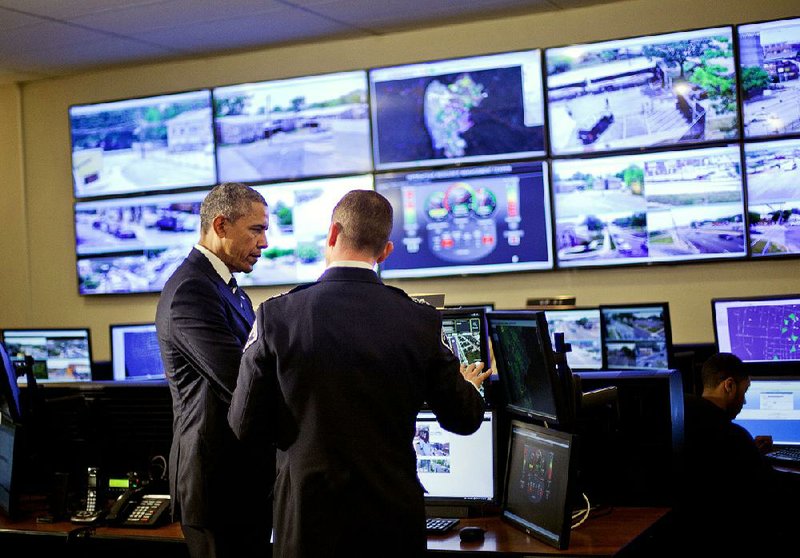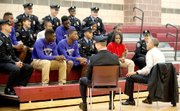WASHINGTON -- President Barack Obama's administration is barring the transfer of some types of military equipment to police departments in an effort to improve trust between law enforcement agencies and communities.
Police forces no longer will be able to acquire surplus equipment -- including some aircraft and vehicles, bayonets, grenade launchers and large-caliber firearms -- from the Pentagon, according to rules that Obama announced Monday during a trip to New Jersey.
In addition to the prohibitions in his order, Obama also is placing a longer list of military equipment under tighter control, including wheeled armored vehicles such as Humvees, manned aircraft, drones, specialized firearms, explosives, battering rams, and riot batons, helmets and shields.
The ban on equipment will take effect immediately, White House officials said; the restrictions on other gear will be phased in so law enforcement agencies can be briefed about the new requirements.
The changes are a response to criticism over how police departments deployed military-style gear to confront protesters in Ferguson, Mo., and other cities.
"We've seen how militarized gear can sometimes give people a feeling like there's an occupying force," Obama said, adding that the heavy equipment could "alienate and intimidate local residents."
The Justice Department separately will begin taking applications for $163 million in grants to help police departments implement practices recommended by a presidential task force. That body was created after a series of deadly encounters between police and unarmed black men. The federal government also plans to do more to help police departments expand the use of body cameras.
Obama announced the steps Monday after a tour through Camden, a city that has been heralded by the White House as a model for improved relations between a community and its police force. The city, long known for poverty and crime, replaced its beleaguered police force with a county-run system that put more officers on the street and prioritized community ties.
Before his speech, Obama met with officers and youths whom they mentor. Earlier in the afternoon, the president toured the Camden County Police Department's real-time operations center.
Obama said that in the past the city seemed "dangerous beyond redemption" but it now stands as a "symbol of promise for the nation."
"This city is on to something," Obama said. "You've made real progress."
Camden's Police Department is participating in a White House initiative intended to improve transparency by releasing information about uses of force, pedestrian and vehicle stops, citations, and officer-involved shootings.
Obama said new federal rules and recommendations will "make sure police departments are being smart about crime and there's enough data for them to be accountable as well."
But the move was denounced by the nation's largest police union, which has argued that Obama and others have politicized the issue and overstated the problem of how police obtain and use the military gear.
"The issue of militarization has been really kind of exaggerated, almost to the point that I don't recognize it at times," said James Pasco, executive director of the Fraternal Order of Police. "The vast majority of the equipment that civilian law enforcement gets from the military is administrative stuff or defensive in nature."
Some police chiefs have stressed that much of the equipment that has been made available by the federal program is radio and dispatch gear that provides cash-strapped departments with valuable updates.
The restrictions on military surplus equipment follow an executive order Obama signed in December requiring agencies to boost oversight of their transfer programs.
The issue of police militarization rose to prominence last year after Darren Wilson, a white police officer in Ferguson, fatally shot unarmed black 18-year-old Michael Brown. Critics questioned why police in full body armor with armored trucks responded to break up protests after the shooting.
A White House review after the Ferguson protests last year found "no consistent standards" for equipment acquisition, Cecilia Munoz, director of the White House Domestic Policy Council, said Sunday during a conference call with reporters.
But starting in October, local governments will have to provide a "clear and persuasive explanation of why they need" certain equipment, Munoz said. The requests will need approval from a governing body, such as a city council, and officers will have to be trained to use the equipment.
Ferguson report
Obama's trip and the action on military-style equipment coincided with the release Monday of a report from the task force formed in response to the Ferguson crisis. The 116-page report, on which Obama based many of the policy changes, calls for law enforcement agencies to "embrace a guardian -- rather than a warrior -- mindset to build trust and legitimacy both within agencies and with the public."
The report contains dozens of recommendations for agencies across the country.
"We are, without a doubt, sitting at a defining moment in American policing," said Ronald Davis, the director of the Office of Community Oriented Policing Services at the Justice Department. "We have a unique opportunity to redefine policing in our democracy, to ensure that public safety becomes more than the absence of crime, but it must also include a presence for justice."
After the Sept. 11, 2001, terrorist attacks, the federal government expanded its efforts to provide police departments with automatic weapons, armored vehicles and other military-style gear through grants at the Homeland Security and Justice departments and through transfers from the Defense Department.
The task force's report cited the police response to the Ferguson unrest as an example of how the "militarization" of police departments can lead to fear and mistrust.
Munoz said the report was "not just a blueprint for us and for local law enforcement agencies, but also for community leaders and others and stakeholders," giving them "some very specific things to be asking for and, frankly, insisting on in order to improve policing practices."
Information for this article was contributed by Justin Sink and Terrence Dopp of Bloomberg News; by Julie Hirschfeld Davis of The New York Times; by Nedra Pickler of The Associated Press; and by David Nakamura and Wesley Lowery of The Washington Post.
A Section on 05/19/2015

